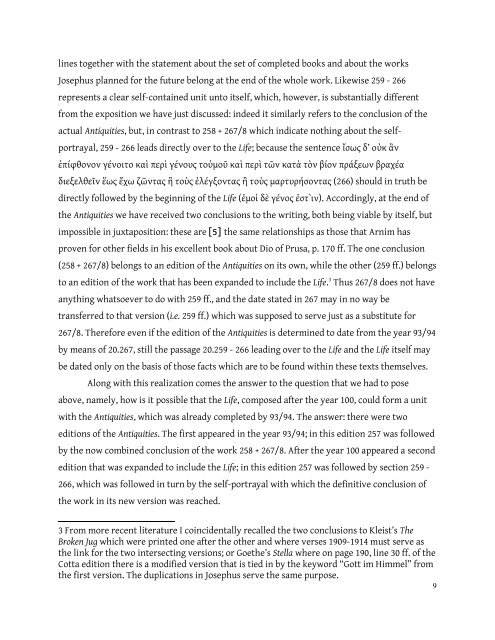The Jewish Historian Flavius Josephus: A Biographical Investigation
The Jewish Historian Flavius Josephus: A Biographical Investigation
The Jewish Historian Flavius Josephus: A Biographical Investigation
You also want an ePaper? Increase the reach of your titles
YUMPU automatically turns print PDFs into web optimized ePapers that Google loves.
lines together with the statement about the set of completed books and about the works<br />
<strong>Josephus</strong> planned for the future belong at the end of the whole work. Likewise 259 - 266<br />
represents a clear self-contained unit unto itself, which, however, is substantially different<br />
from the exposition we have just discussed: indeed it similarly refers to the conclusion of the<br />
actual Antiquities, but, in contrast to 258 + 267/8 which indicate nothing about the selfportrayal,<br />
259 - 266 leads directly over to the Life; because the sentence ἴσως δ’ οὐκ ἂν<br />
ἐπίφθονον γένοιτο καὶ περὶ γένους τοὐμοῦ καὶ περὶ τῶν κατὰ τὸν βίον πράξεων βραχέα<br />
διεξελθεῖν ἕως ἔχω ζῶντας ἢ τοὺς ἐλέγξοντας ἢ τοὺς μαρτυρήσοντας (266) should in truth be<br />
directly followed by the beginning of the Life (ἐμοὶ δὲ γένος ἐστ`ιν). Accordingly, at the end of<br />
the Antiquities we have received two conclusions to the writing, both being viable by itself, but<br />
impossible in juxtaposition: these are [5] the same relationships as those that Arnim has<br />
proven for other fields in his excellent book about Dio of Prusa, p. 170 ff. <strong>The</strong> one conclusion<br />
(258 + 267/8) belongs to an edition of the Antiquities on its own, while the other (259 ff.) belongs<br />
to an edition of the work that has been expanded to include the Life. 3 Thus 267/8 does not have<br />
anything whatsoever to do with 259 ff., and the date stated in 267 may in no way be<br />
transferred to that version (i.e. 259 ff.) which was supposed to serve just as a substitute for<br />
267/8. <strong>The</strong>refore even if the edition of the Antiquities is determined to date from the year 93/94<br />
by means of 20.267, still the passage 20.259 - 266 leading over to the Life and the Life itself may<br />
be dated only on the basis of those facts which are to be found within these texts themselves.<br />
Along with this realization comes the answer to the question that we had to pose<br />
above, namely, how is it possible that the Life, composed after the year 100, could form a unit<br />
with the Antiquities, which was already completed by 93/94. <strong>The</strong> answer: there were two<br />
editions of the Antiquities. <strong>The</strong> first appeared in the year 93/94; in this edition 257 was followed<br />
by the now combined conclusion of the work 258 + 267/8. After the year 100 appeared a second<br />
edition that was expanded to include the Life; in this edition 257 was followed by section 259 -<br />
266, which was followed in turn by the self-portrayal with which the definitive conclusion of<br />
the work in its new version was reached.<br />
3 From more recent literature I coincidentally recalled the two conclusions to Kleist’s <strong>The</strong><br />
Broken Jug which were printed one after the other and where verses 1909-1914 must serve as<br />
the link for the two intersecting versions; or Goethe’s Stella where on page 190, line 30 ff. of the<br />
Cotta edition there is a modified version that is tied in by the keyword “Gott im Himmel” from<br />
the first version. <strong>The</strong> duplications in <strong>Josephus</strong> serve the same purpose.<br />
9
















